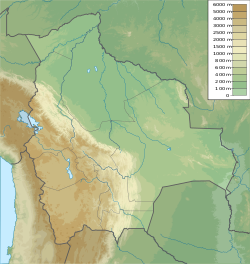Toro Toro Formation
The Toro Toro Formation is a Late Campanian geologic formation pertaining to the Puca Group of central Bolivia. The porous yellowish medium-to-coarse grained ferruginous (iron-containing) sandstones and mudstones with gypsum intercalations, deposited in a beach environment, preserve many ichnofossils of Ligabueichnium bolivianum, Dromaeopodus sp.,[1] Ornithopoda indet., Theropoda indet. and Titanosauridae indet.[2] The formation has provided the earliest known tracksite of dinosaurs in Bolivia.[3] The Toro Toro Formation represents part of the postrift stage in an alluvial to deltaic environment within the Potosí Basin. The formation is a local equivalent of the Chaunaca Formation.[4] The most famous of the dinosaur tracksites is Cal Orcko, however these are in the El Molino Formation
| Toro Toro Formation | |
|---|---|
| Stratigraphic range: Late Campanian ~ | |
 Dinosaur ichnofossils in the Toro Toro Formation | |
| Type | Geological formation |
| Unit of | Puca Group |
| Lithology | |
| Primary | Sandstone |
| Other | Mudstone, gypsum |
| Location | |
| Coordinates | 18°06′S 65°48′W / 18.1°S 65.8°W |
| Approximate paleocoordinates | 21°18′S 47°48′W / 21.3°S 47.8°W |
| Region | Cochabamba Department |
| Country | |
| Extent | Potosí Basin |
| Type section | |
| Named for | Torotoro National Park |
See also
References
- ^ Apesteguía et al., 2011, p.663
- ^ Toro Toro, Pista de Danzas at Fossilworks.org
- ^ Lockley et al., 2002, p.389
- ^ Apesteguía et al., 2011, p.662
Bibliography
- Apesteguía, Sebastián; De Valais, Silvina; Ríos Cordero, Giovanni; Medina Ramírez, Omar (2011), "New Ichnological Record from the Late Campanian Toro Toro Formation at Toro Toro, Potosí (bolivia): First probable Dromaeosaurid Tracks from South America", Ameghiniana, 48 (4): 662–667, doi:10.5710/AMGH.v48i4(341), hdl:11336/9519, retrieved 2019-03-03
- Lockley, M.G.; Schulp, A.S.; Meyer, C.A.; Leonardi, G.; Mamani, D.K. (2002), "Titanosaurid trackways from the Upper Cretaceous of Bolivia: evidence for large manus, wide-gauge locomotion and gregarious behaviour", Cretaceous Research, 23 (3): 383–400, Bibcode:2002CrRes..23..383L, doi:10.1006/cres.2002.1006, retrieved 2019-03-03
